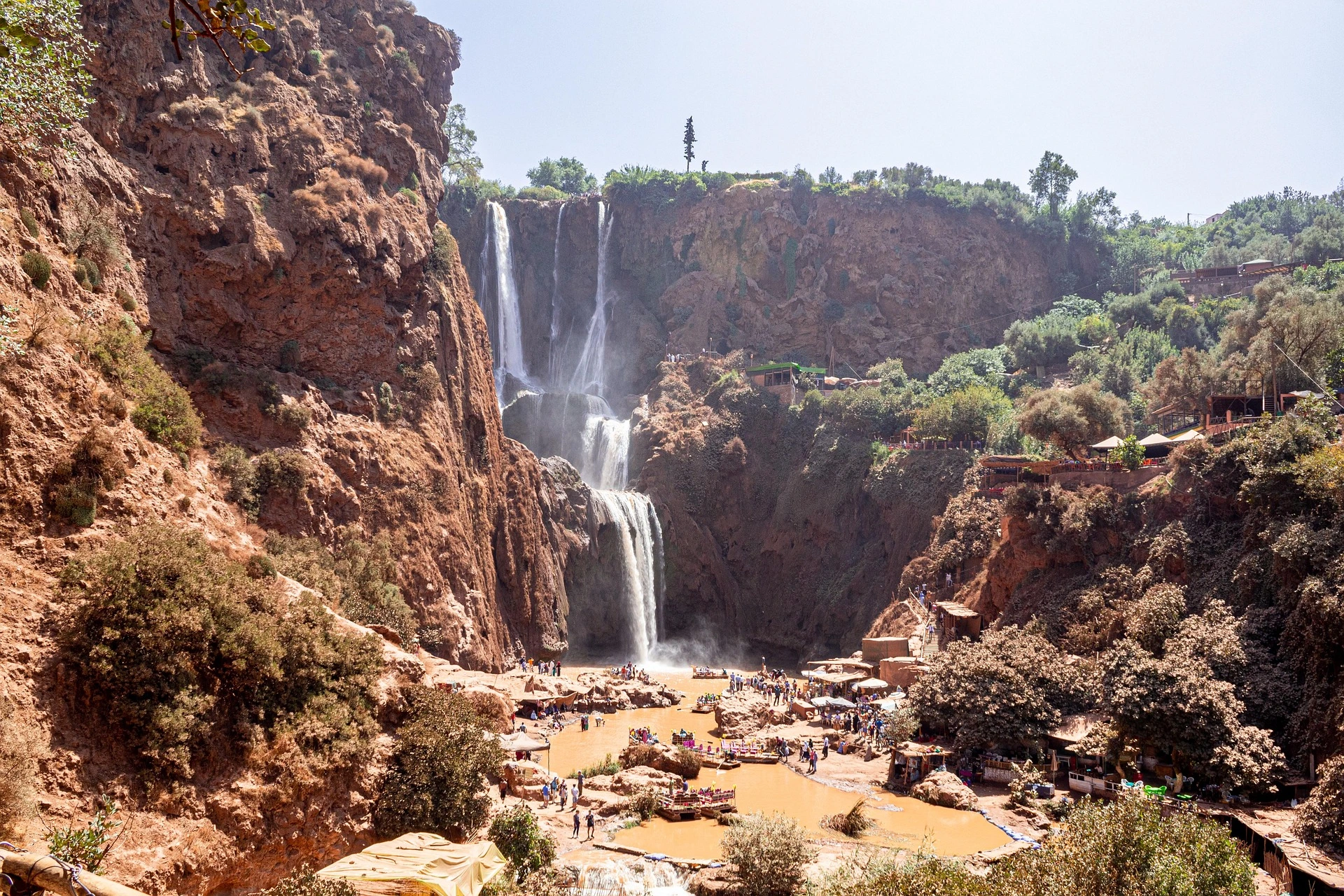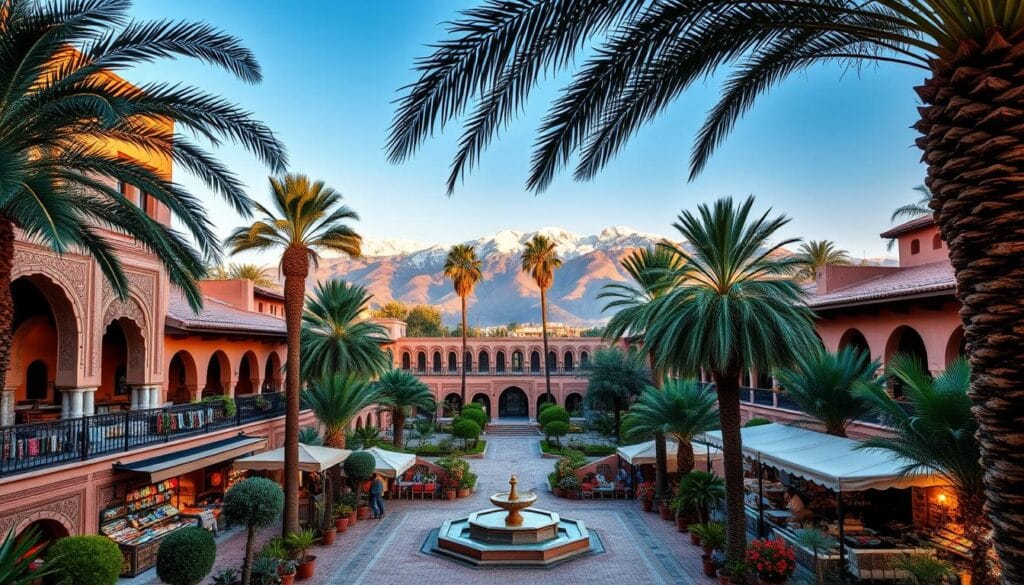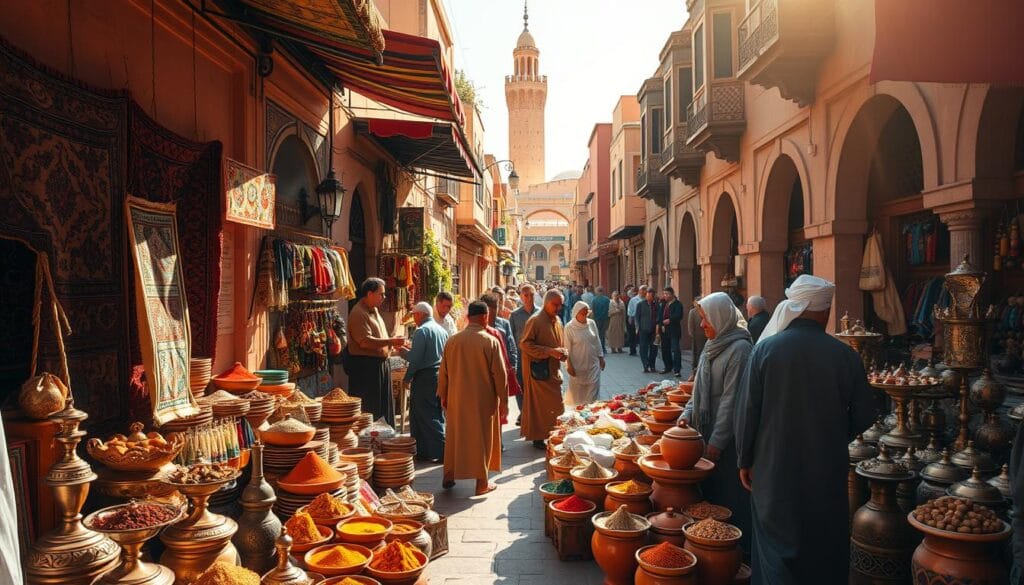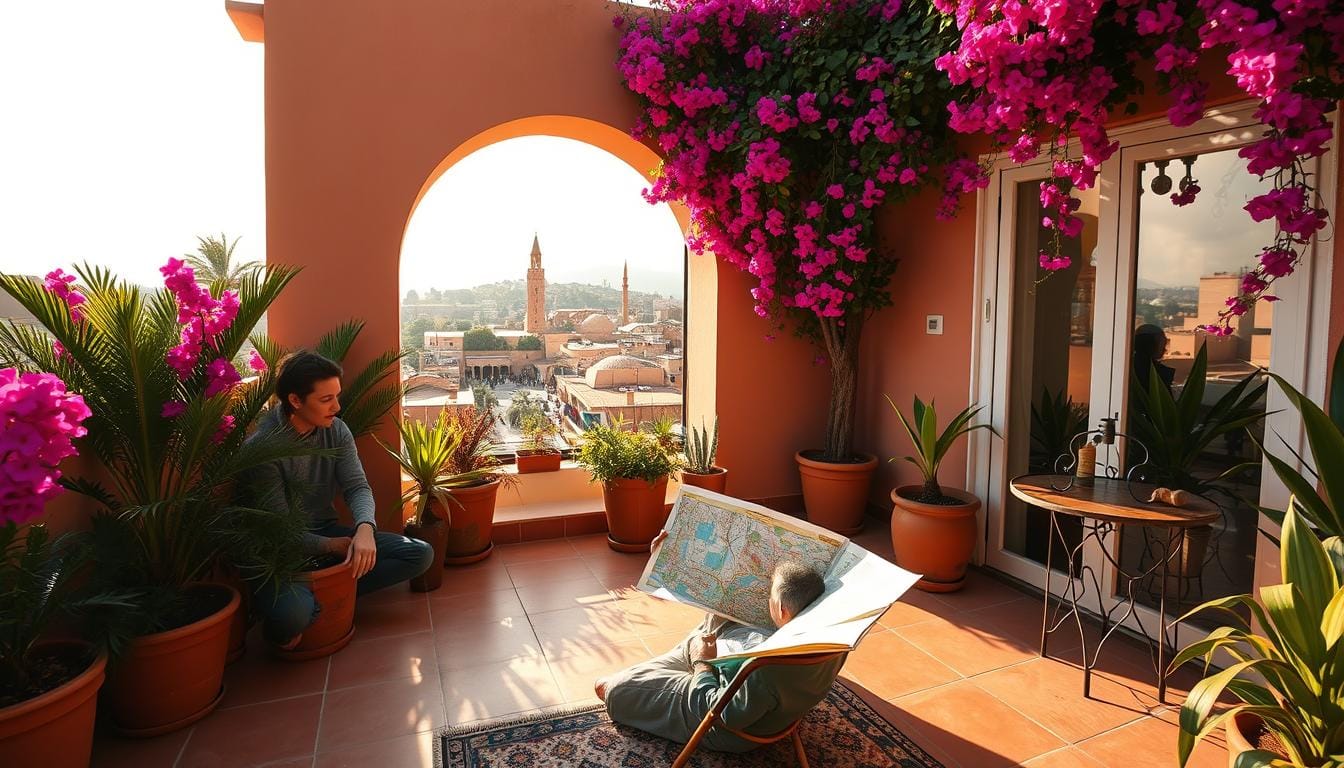Morocco Travel Guide 2025: Essential Tips for Your Trip
Morocco Travel Guide 2025. As you prepare for your journey to this enchanting country, you’re likely filled with excitement and anticipation. Imagine yourself wandering through the vibrant streets of Marrakech, taking in the rich history and culture that Morocco has to offer.
From the bustling markets to the serene Sahara Desert, your experience is sure to be unforgettable. In this guide, we’ll walk you through the essential tips to make your trip truly amazing, covering everything you need to know to navigate this incredible destination with ease.
With our expert advice, you’ll be well-prepared for an enriching experience that will leave you with lifelong memories.
Table of Contents
ToggleOverview of Morocco: A Gateway to North Africa
Morocco, a country in the northwest corner of Africa, is a treasure trove of cultural heritage and natural beauty. As you plan your trip, understanding the country’s diverse geography and climate is crucial for making the most of your experience.
Geographic Diversity and Climate
Morocco boasts a varied landscape, ranging from the majestic Atlas Mountains to the vast expanse of the Sahara Desert. The climate varies significantly across different regions, with the coastal areas generally being milder than the inland regions. The diverse geography means that the weather can be quite different depending on where you are, making it essential to pack accordingly.
In the mountainous regions, temperatures can drop significantly at night, even during the summer months. Conversely, the desert regions are known for their extreme heat during the day. Understanding these climatic variations will help you prepare for your journey.
Key Attractions and Destinations
Morocco is home to a plethora of attractions that cater to all kinds of travelers. From the bustling souks of Marrakech to the historic city of Fez, there’s no shortage of exciting places to explore. The vibrant atmosphere of these cities is sure to leave a lasting impression.
Some of the top attractions include the Medina of Marrakech, a UNESCO World Heritage site, and the Chefchaouen, known for its picturesque blue buildings. The ancient city of Volubilis is another must-visit, with its well-preserved Roman ruins.
- Explore the bustling souks and markets
- Visit historic cities like Fez and Marrakech
- Relax on the beautiful beaches of Essaouira
Whether you’re interested in history, culture, or simply enjoying the natural beauty of Morocco, there’s something for everyone. By understanding the geographic diversity and climate, you can better plan your itinerary to include the best places to visit in Morocco.
Planning Your Trip: When to Visit Morocco
Planning your trip to Morocco requires considering the best time to visit, taking into account the country’s rich cultural events and festivals. Morocco’s climate varies greatly from one region to another, making it essential to choose the right time for your travel plans.
Best Times for Tourists
The best time to visit Morocco is during the spring (March to May) and autumn (September to November), when the weather is mild and pleasant across most regions. These periods are ideal for exploring the bustling cities, historic sites, and natural landscapes.
Summer can be very hot, especially in the desert regions, while winters can be cool, particularly in the mountains. If you’re planning to visit the Sahara Desert, it’s best to avoid the peak summer months unless you’re prepared for extreme heat.

Festivals and Events to Experience
Morocco hosts a variety of festivals and events throughout the year, showcasing its vibrant culture and traditions. Some of the notable events include:
- The Marrakech International Film Festival, which attracts filmmakers and cinema enthusiasts from around the world.
- The Essaouira Gnawa Music Festival, celebrating Gnawa music and culture.
- The Fez Festival of World Sacred Music, featuring performances by musicians from diverse cultural backgrounds.
| Event | Location | Time of Year |
|---|---|---|
| Marrakech International Film Festival | Marrakech | December |
| Essaouira Gnawa Music Festival | Essaouira | June |
| Fez Festival of World Sacred Music | Fez | May/June |
Attending these events can add a unique dimension to your Moroccan adventure, allowing you to experience the country’s rich cultural heritage firsthand.
Getting There: Travel Options to Morocco
You have several options when it comes to flying to Morocco, making it easier to plan your trip according to your preferences and budget.
For travelers from the United States, several major airlines offer direct flights from key cities. For instance, you can fly directly from New York, Los Angeles, or Miami to Marrakech or Casablanca.
Direct Flights from Major U.S. Cities
Direct flights are available from major U.S. cities, providing a convenient way to reach Morocco without the hassle of layovers. Some airlines offering these services include:
- American Airlines
- Delta Air Lines
- United Airlines
- Emirates
- Turkish Airlines (with a potential layover, but often considered for connections)
| Airline | Departure City | Destination |
|---|---|---|
| American Airlines | New York (JFK) | Casablanca (CMN) |
| Delta Air Lines | New York (JFK) | Marrakech (RAK) |
| United Airlines | Washington D.C. (IAD) | Marrakech (RAK) |
Alternative Routes and Connections
If you’re looking for more affordable options or traveling from a different location, consider alternative routes and connections. You can fly to major European hubs like London, Paris, or Amsterdam and then connect to a flight to Morocco.
For example, flying with British Airways to London and then connecting with Royal Air Maroc to Marrakech is a viable option. Similarly, you can use airlines like Iberia or TAP Air Portugal for connections through Madrid or Lisbon.
When planning your trip, it’s essential to compare prices and flight schedules to find the best option for your Morocco travel itinerary. Booking in advance can also help you secure better deals.
By understanding your travel options, you can make informed decisions and enjoy a smooth journey to Morocco, setting the stage for an unforgettable experience.
Visa and Entry Requirements for U.S. Travelers
Before you embark on your Moroccan adventure, it’s crucial to understand the visa and entry requirements as a U.S. traveler. Ensuring you comply with these regulations will help you avoid any complications upon arrival and make your trip more enjoyable.
Morocco is a country rich in history and culture, offering numerous must-see places that showcase its diverse heritage. From the bustling streets of Marrakech to the historic city of Fez, understanding the entry requirements will allow you to focus on exploring these incredible destinations.
Passport Validity and Visa Process
As a U.S. citizen, you’ll need a valid passport to enter Morocco. Your passport should be valid for at least six months beyond your planned departure date from Morocco. It’s also essential to have at least two blank pages in your passport for entry stamps.
For U.S. travelers, a visa is not required for tourism or business stays up to 90 days. However, it’s crucial to check the official government website or consult with the Moroccan embassy or consulate for the most current visa requirements before your trip.
Health and Safety Regulations
Morocco has specific health and safety regulations that U.S. travelers should be aware of. It’s recommended that you are up-to-date on all routine vaccinations and consider additional vaccinations such as Hepatitis A and Typhoid, depending on your travel plans and activities.
Furthermore, it’s advisable to take certain health precautions, such as drinking bottled or filtered water and avoiding undercooked food. Being mindful of these health guidelines will help ensure your safety during your visit.
Understanding and respecting Moroccan culture and traditions is also vital for a harmonious and enjoyable trip. Morocco is a Muslim country with conservative norms, so dressing modestly and being respectful of local customs will enhance your experience and interactions with the locals.
Navigating Morocco: Transportation Options
Whether you’re exploring the bustling streets of Marrakech or venturing into the countryside, Morocco offers various transportation options to suit your travel needs. Understanding the transportation network is key to making the most of your trip.
Public Transport in Major Cities
Major cities like Marrakech, Rabat, and Casablanca have well-organized public transportation systems, including buses and trains. The Al Bidaoui train service connects major cities, making it a convenient option for travelers. You can also use Supratours buses, which offer comfortable and relatively affordable travel between cities.
Within cities, you can use local buses or petit taxis (small taxis) for shorter journeys. It’s advisable to agree on the fare before you start your journey. For a more modern experience, ride-hailing apps like Careem and Uber are available in larger cities.
Car Rentals and Driving Tips
Renting a car gives you the freedom to explore Morocco at your own pace. Many international car rental companies have offices at airports and in city centers. To rent a car, you’ll need a valid driver’s license and credit card.
Driving in Morocco can be challenging, especially in urban areas where traffic can be chaotic. It’s essential to be cautious and aware of local driving customs. Always drive defensively, and be prepared for unexpected situations.
- Ensure you have a valid driver’s license.
- Familiarize yourself with local traffic laws.
- Be cautious of pedestrians and other vehicles.
By understanding your transportation options and being prepared, you can navigate Morocco with ease and enjoy your travel experience.
Accommodations: Where to Stay in Morocco
Morocco offers a diverse range of accommodations to suit every traveler’s needs, from budget-friendly options to luxury riads. Choosing the right type of lodging can significantly enhance your travel experience and provide a comfortable base for exploring the country’s top attractions.
Types of Lodging Available
When planning a trip to Morocco, you’ll find various accommodation options, including:
- Riads: Traditional Moroccan houses with interior gardens
- Hotels: Ranging from budget-friendly to luxury establishments
- Guesthouses: Family-run establishments offering a homey atmosphere
- Riads with a pool: Ideal for relaxation in a serene setting
- Desert camps: For an immersive experience in the Sahara Desert
| Accommodation Type | Price Range | Amenities |
|---|---|---|
| Riads | $50-$200 per night | Traditional decor, interior gardens, often breakfast included |
| Luxury Hotels | $150-$500 per night | Pools, spas, fine dining, concierge services |
| Guesthouses | $30-$100 per night | Homey atmosphere, often family-run, simple amenities |

Recommended Hotels and Riads
Some standout accommodations in Morocco include:
- Riad Yacout in Marrakech, known for its stunning architecture and serene courtyard
- The Ksar Ighnda in the Atlas Mountains, offering a luxurious glamping experience
- Hotel Sofitel Marrakech Palais Imperial, a luxurious hotel with a blend of traditional and modern amenities
- Riad Les Ottomans in Marrakech, praised for its beautiful decor and exceptional service
These recommendations cater to different tastes and budgets, ensuring that you find the perfect place to stay during your visit to Morocco.
Culinary Delights: Food & Drink in Morocco
The flavors of Morocco are a sensory journey, with aromatic spices, vibrant markets, and traditional cooking methods coming together to create a unique gastronomic experience. As you explore the country’s culinary delights, you’ll discover a rich tapestry of flavors influenced by its strategic location at the crossroads of Africa, Europe, and the Arab world.
Must-Try Dishes and Street Food
Moroccan cuisine is known for its hearty and flavorful dishes, often made with a combination of local ingredients such as olives, preserved lemons, and a variety of spices. Some must-try dishes include:
- Tagine: A slow-cooked stew named after the clay pot in which it’s cooked, typically made with meat, vegetables, and dried fruits.
- Couscous: A traditional North African dish made from semolina flour, often served with vegetables, meat, and sauce.
- Harira: A comforting soup made with tomatoes, lentils, chickpeas, and spices, often enjoyed as a starter or snack.
Street food is also a significant part of Morocco’s culinary scene, with popular items like msemen (a thin, folded pancake) and maouche (grilled meat skewers) being readily available in markets and souks.
Traditional Moroccan Beverages
No culinary journey in Morocco is complete without trying the local beverages. Some traditional drinks include:
- Mint Tea: A refreshing and iconic beverage made with green tea, fresh mint leaves, and sugar, often served as a sign of hospitality.
- Orange Blossom Water: A fragrant and floral drink made from the distillation of orange blossoms, used in desserts and drinks.
- Lben: A traditional yogurt drink, often consumed as a refreshing beverage or used as an ingredient in cooking.
Exploring Morocco’s culinary delights is an adventure that will leave you with a deep appreciation for the country’s rich gastronomic heritage. Be sure to immerse yourself in the local food culture by trying these and other traditional dishes and beverages during your visit.
Cultural Etiquette: Dos and Don’ts
To have a respectful and enriching experience in Morocco, it’s crucial to familiarize yourself with the local etiquette. Morocco is a country with a rich cultural heritage, and understanding the customs and traditions will help you navigate everyday interactions with confidence.
Customs and Traditions to Respect
Morocco is an Islamic country, and many of its customs and traditions are rooted in Islam. For instance, during the holy month of Ramadan, many Moroccans fast from dawn to sunset. You should be respectful of this practice by avoiding eating, drinking, or smoking in public during daylight hours. It’s also a good idea to learn a few basic phrases in Arabic, such as “hello” (As-salamu alaykum) and “thank you” (Shukraan), as this will be appreciated by the locals.
When visiting mosques or private homes, you should dress modestly and remove your shoes when required. It’s also customary to use your right hand when giving or receiving something, as the left hand is considered unclean.

Appropriate Dress Guidelines
Dressing modestly is key when traveling in Morocco. For women, this means covering your shoulders and knees, and avoiding revealing clothing. Men should also dress modestly, avoiding shorts and sleeveless shirts, especially when visiting rural areas or mosques.
When visiting the beach, it’s worth noting that Morocco is becoming more relaxed about beachwear, but it’s still a good idea to cover up when leaving the beach area. In general, dressing conservatively will help you blend in and earn the respect of the locals.
By being mindful of these customs and traditions, you’ll be able to enjoy a more authentic and respectful experience in Morocco. Whether you’re exploring the bustling souks or relaxing in a riad, understanding the local culture will enrich your travels.
Exploring Moroccan Souks and Markets
Exploring Moroccan souks and markets is an adventure that combines cultural immersion with the thrill of the hunt for unique treasures. As you navigate through the vibrant stalls and colorful goods, you’ll experience the heart of Moroccan commerce and community.
Top Markets to Visit
Morocco is home to some of the most fascinating markets in the world, each offering a distinct shopping experience. Here are some of the top markets to visit:
- Marrakech Souk: Known for its vibrant atmosphere and wide range of goods, from spices to handicrafts.
- Fes Souk: Offers a more traditional shopping experience, with a focus on local crafts and textiles.
- Rabat Medina: A blend of traditional and modern shopping, with a variety of goods and souvenirs.
These markets are not just shopping destinations but are also among the best places to visit in Morocco, offering insights into local culture and traditions.
Bargaining Tips for Shoppers
Bargaining is an integral part of the shopping experience in Moroccan souks and markets. Here are some tips to help you navigate the process:
- Research beforehand: Knowing the market value of the items you’re interested in will help you make informed decisions.
- Be respectful: Bargaining should be a friendly negotiation, not a confrontation.
- Start with a low offer: Vendors expect this, and it sets the stage for the negotiation.
- Be willing to walk away: If the price isn’t right, walking away can sometimes prompt the vendor to lower the price.
By mastering the art of bargaining, you’ll not only get better deals but also enjoy a more authentic experience at these top attractions in Morocco.
Adventure Activities: Beyond the Cities
Venture beyond Morocco’s cities to uncover a world of thrilling adventures and breathtaking natural beauty. Morocco is a country that offers a diverse range of activities for the adventurous traveler.
One of the most exciting ways to experience Morocco’s natural beauty is by hiking in the Atlas Mountains. The Atlas range offers some of the most spectacular hiking trails in North Africa, with routes suitable for all levels of hikers. You can explore traditional Berber villages, lush valleys, and dramatic mountain peaks.
Hiking in the Atlas Mountains
The Atlas Mountains are a haven for hikers, with trails that range from gentle day hikes to more challenging multi-day treks. You can hike to the summit of Mount Toubkal, the highest peak in North Africa, or explore the scenic valleys and villages below. Many local guides and tour operators offer guided hikes, ensuring a safe and enriching experience.
When planning your hike, consider the time of year and weather conditions. Spring and autumn are ideal times to visit, with mild temperatures and fewer crowds. Make sure to pack comfortable hiking boots, layers for changing weather, and plenty of water and snacks.
Desert Excursions and Camel Rides
No trip to Morocco is complete without experiencing the majestic Sahara Desert. Take a desert excursion and ride a camel through the golden dunes, watching the sunset over the vast expanse of sand. You can choose from a range of desert tours, from day trips to multi-day adventures that include camping under the stars.
A camel ride through the Sahara is a quintessential Moroccan experience. You’ll be accompanied by knowledgeable guides who will regale you with stories of the desert’s history and culture. As the sun sets, you’ll enjoy traditional Berber hospitality, with delicious meals and warm hospitality around the campfire.
To make the most of your desert excursion, plan ahead and choose a reputable tour operator. Consider the time of year, with winter and spring being the best times to visit the desert. Don’t forget to pack comfortable clothing, sunscreen, and a camera to capture the breathtaking scenery.
When planning your Morocco travel itinerary, be sure to include these must-see places in Morocco for an unforgettable adventure.
Conclusion: Making the Most of Your Moroccan Experience
As you finalize your Morocco travel guide 2025, it’s essential to tie up loose ends and prepare for an unforgettable adventure. With your trip to Morocco just around the corner, you can now focus on the finer details that will make your experience truly memorable.
Last-Minute Preparations
Double-check your itinerary, ensuring that you’ve planned for the best times to visit popular destinations and experience the vibrant festivals that Morocco has to offer. When planning a trip to Morocco, consider registering with your government’s travel advisory website to stay informed about local conditions.
Resources for Further Research
For more information on Morocco, consult reputable sources such as the Moroccan Ministry of Tourism or travel guides from established publishers. These resources will help you stay up-to-date on local customs, safety guidelines, and exciting events, ensuring that your trip is both enjoyable and stress-free.

